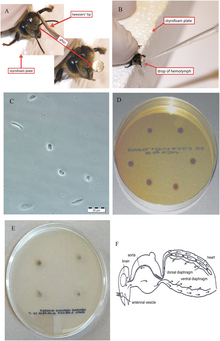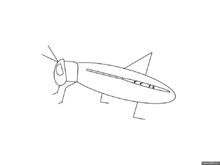Hemolymph,orhaemolymph,is a fluid, analogous to thebloodinvertebrates,that circulates in the interior of the arthropod (invertebrate) body, remaining in direct contact with the animal's tissues. It is composed of a fluid plasma in which hemolymph cells calledhemocytesare suspended. In addition to hemocytes, the plasma also contains many chemicals. It is the major tissue type of theopen circulatory systemcharacteristic ofarthropods(for example,arachnids,crustaceansandinsects).[1][2]In addition, some non-arthropods such asmolluskspossess a hemolymphatic circulatory system.



Oxygen-transport systems were long thought unnecessary in insects, but ancestral and functionalhemocyaninhas been found in the hemolymph.[3]Insect "blood" generally does not carryhemoglobin,although hemoglobin may be present in the tracheal system instead and play some role in respiration.[4]
Method of transport
editIn thegrasshopper,the closed portion of the system consists of tubular hearts and an aorta running along the dorsal side of the insect. The hearts pump hemolymph into the sinuses of thehemocoelwhere exchanges of materials take place. The volume of hemolymph needed for such a system is kept to a minimum by a reduction in the size of the body cavity. The hemocoel is divided into chambers called sinuses.
Coordinated movements of the body muscles gradually bring the hemolymph back to the dorsal sinus surrounding the hearts. Between contractions, tiny valves in the wall of the hearts open and allow hemolymph to enter. Hemolymph fills all of the interior (thehemocoel) of the animal's body and surrounds all cells. It containshemocyanin,acopper-based protein that turns blue when oxygenated, instead of theiron-basedhemoglobininred blood cellsfound in vertebrates, giving hemolymph a blue-green color rather than the red color of vertebrate blood. When not oxygenated, hemolymph quickly loses its color and appears grey.
The hemolymph of lower arthropods, including mostinsects,is not used for oxygen transport because these animalsrespiratethrough other means, such as tracheas, but it does contain nutrients such as proteins and sugars. Muscular movements by the animal duringlocomotioncan facilitate hemolymph movement, but diverting flow from one area to another is limited. When theheartrelaxes, hemolymph is drawn back toward the heart through open-ended pores called ostia.[5]Note that the term "ostia"is not specific to insect circulation; it literally means" doors "or" openings ", and must be understood in context.
Constituents
editHemolymph can contain nucleating agents that confer extracellular freezing protection. Such nucleating agents have been found in the hemolymph of insects of several orders, i.e.,Coleoptera(beetles),Diptera(flies), andHymenoptera.[6]
Inorganic
editHemolymph is composed ofwater,inorganicsalts(mostlysodium,chlorine,potassium,magnesium,andcalcium), andorganic compounds(mostlycarbohydrates,proteins,andlipids). The primary oxygen transporter molecule ishemocyanin.[7][3]
Amino acids
editArthropodhemolymph contains high levels of free amino acids. Most amino acids are present but their relative concentrations vary from species to species. Concentrations of amino acids also vary according to the arthropod stage of development. An example of this is the silkworm and its need for glycine in the production of silk.[8]
Proteins
editProteins present in the hemolymph vary in quantity during the course of development. These proteins are classified by their functions: chroma proteins, protease inhibitors, storage, lipid transport, enzymes, the vitellogenins, and those involved in the immune responses of arthropods. Some hemolymphic proteins incorporate carbohydrates and lipids into the structure.[9]
Other organic constituents
editNitrogenmetabolism end products are present in the hemolymph in low concentrations. These includeammonia,allantoin,uric acid,andurea.Arthropodhormonesare present, most notably the juvenile hormone.Trehalosecan be present and sometimes in great amounts along withglucose.These sugar levels are maintained by the control of hormones. Othercarbohydratescan be present. These includeinositol,sugar alcohol,hexosamines,mannitol,glyceroland those components that are precursors tochitin.[1]
Hemocytes
editThere are free-floating cells, thehemocytes,within the hemolymph. They play a role in the arthropodimmune system.The immune system resides in the hemolymph.
Comparisons to vertebrates
editThisopen systemmight appear to be inefficient compared to the closed circulatory systems of thevertebrates,but the two systems have very different demands placed on them. In vertebrates, the circulatory system is responsible for transporting oxygen to all the tissues and removing carbon dioxide from them. It is this requirement that establishes the level of performance demanded of the system. The efficiency of the vertebrate system is far greater than is needed for transporting nutrients, hormones, and so on, whereas in insects, exchange of oxygen and carbon dioxide occurs in thetracheal system.Hemolymph plays no part in the process in most insects. Only in a few insects living in low-oxygen environments are there hemoglobin-like molecules that bind oxygen and transport it to the tissues. Therefore, the demands placed upon the system are much lower. Some arthropods and most molluscs possess thecopper-containinghemocyanin,however, for oxygen transport.[11]
Specialist uses
editIn some species, hemolymph has other uses than just being a blood analogue. As the insect or arachnid grows, the hemolymph works something like a hydraulic system, enabling the insect or arachnid to expand segments before they aresclerotized.It can also be used hydraulically as a means of assisting movement, such as inarachnid locomotion.Some species of insect or arachnid are able toautohaemorrhagewhen they are attacked by predators.[12]Queens of the ant genusLeptanillaare fed with hemolymph produced by thelarvae.[13]On the other hand,Pemphigus spyrothecaeutilize hemolymph as an adhesive, allowing the species to stick to predators and subsequently attack the predator; it was found that with larger predators, more aphids were stuck after the predator was defeated.
See also
editReferences
edit- ^abChapman 1998,p.[page needed].
- ^Wyatt, G. R. (1961). "The Biochemistry of Insect Hemolymph".Annual Review of Entomology.6:75–102.doi:10.1146/annurev.en.06.010161.000451.S2CID218693.
- ^abHagner-Holler, Silke; Schoen, Axel; Erker, Wolfgang; Marden, James H.; Rupprecht, Rainer; Decker, Heinz; Burmester, Thorsten (2004-01-20)."A respiratory hemocyanin from an insect".Proceedings of the National Academy of Sciences.101(3): 871–874.Bibcode:2004PNAS..101..871H.doi:10.1073/pnas.0305872101.ISSN0027-8424.PMC321773.PMID14715904.
- ^Hankeln, Thomas; Jaenicke, Viviane; Kiger, Laurent; Dewilde, Sylvia; Ungerechts, Guy; Schmidt, Marc; Urban, Joachim; Marden, Michael C.; Moens, Luc; Burmester, Thorsten (2002-06-04)."Characterization ofDrosophilaHemoglobin".Journal of Biological Chemistry.277(32): 29012–29017.doi:10.1074/jbc.m204009200.ISSN0021-9258.PMID12048208.
- ^Richards, O. W.; Davies, R.G. (1977).Imms' General Textbook of Entomology: Volume 1: Structure, Physiology and Development Volume 2: Classification and Biology.Berlin: Springer.ISBN0-412-61390-5.
- ^Zachariassen, Karl Erik; Baust, John G.; Lee, Richard E. (1982). "A method for quantitative determination of ice nucleating agents in insect hemolymph".Cryobiology.19(2): 180–4.doi:10.1016/0011-2240(82)90139-0.PMID7083885.
- ^Sowers, A.D; Young, S.P; Grosell, M.; Browdy, C.L.; Tomasso, J.R. (2006). "Hemolymph osmolality and cation concentrations in Litopenaeus vannamei during exposure to artificial sea salt or a mixed-ion solution: Relationship to potassium flux".Comparative Biochemistry and Physiology Part A: Molecular & Integrative Physiology.145(2): 176–80.doi:10.1016/j.cbpa.2006.06.008.PMID16861020.
- ^Chapman 1998,p. 108.
- ^Chapman 1998,p. 111.
- ^Chapman 1998,p. 114.
- ^Decker, H.; Hellmann, N.; Jaenicke, E.; Lieb, B.; Meissner, U.; Markl, J. (1 October 2007)."Minireview: Recent progress in hemocyanin research".Integrative and Comparative Biology.47(4): 631–644.doi:10.1093/icb/icm063.PMID21672868.
- ^Bateman, P. W.; Fleming, P. A. (2009). "There will be blood: Autohaemorrhage behaviour as part of the defence repertoire of an insect".Journal of Zoology.278(4): 342–8.doi:10.1111/j.1469-7998.2009.00582.x.
- ^GenusLeptanillaAustralian Ants Online
Sources
edit- Chapman, R.F. (1998).The Insects: Structure and Function(4th ed.). Cambridge: Cambridge University Press.ISBN978-0-521-57890-5.
External links
edit- "Do insects have blood?".Boston Globe.October 17, 2005.Archivedfrom the original on October 2, 2022.
- Bolstad, Kat (May 2, 2008)."Blue Squid Blood - Murky Water".Te Papa Tongarewa Museum of New Zealand.Archived fromthe originalon April 2, 2015.